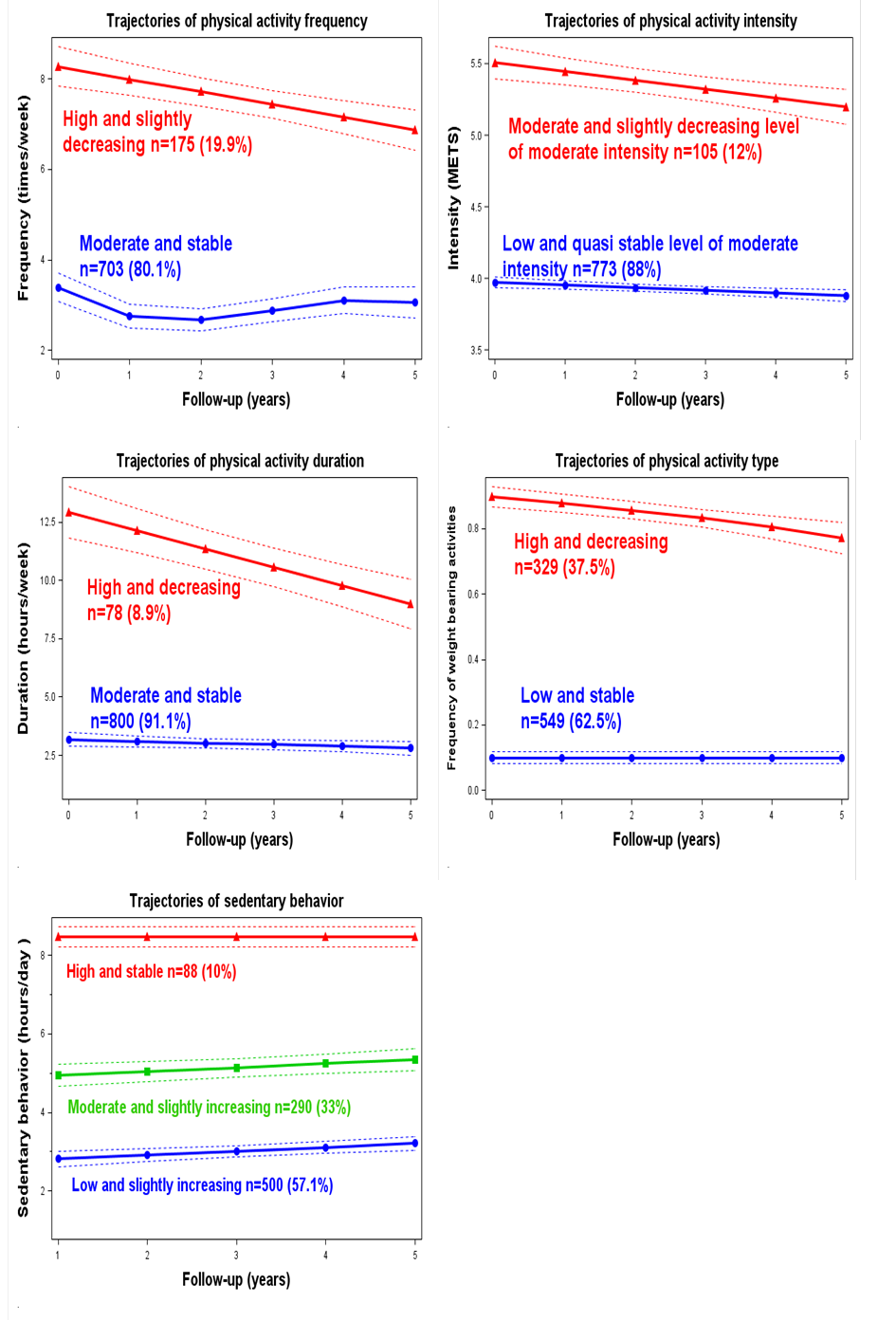Session Information
Date: Tuesday, November 7, 2017
Title: Health Services Research I: Cost Drivers in Rheumatic Disease
Session Type: ACR Concurrent Abstract Session
Session Time: 4:30PM-6:00PM
Background/Purpose: Regular Physical Activity (PA) at a moderate level of intensity for approximately 2.5 hours per week is recommended in the management of hip and/or Knee osteoarthritis (OA). We aimed to identify evolution patterns of PA components (frequency, duration, intensity, type (weight bearing or not)) and Sedentary Behavior (SB) over five years and to determine baseline predictors for each trajectory in a representative cohort of patient with hip and/or knee OA.
Methods: Patients from the KHOALA cohort, a population-based multicenter cohort of 878 patients with symptomatic knee and/or hip OA, aged between 40 and 75 years old were included. For the purpose of the study, we used data collected between inclusion and the fifth year of follow-up. PA and SB were measured by the Modifiable Activity Questionnaire (MAQ). Evolution patterns of PA components and SB were identified using group-based trajectory analysis. Association of socio-demographic and clinical characteristics with PA and SB patterns were identified by multivariate logistic regression.
Results: Two groups of trajectories were identified for each PA component and three for the SB (figure1). Baseline sociodemographic and clinical characteristics were associated with Frequency and Type component trajectories: women were more often in the “moderate and stable duration” of PA group and in the “low and stable frequency of weight bearing PA” group than in the high groups; patients aged 60 years and older were in the “high and decreasing frequency” of PA group (OR= 3.2 [1.2-8.1]). Patients with impaired patients reported outcome variables (womac, pain VAS, SF36 vitality) were more often in the group of “low frequency of weight bearing PA” than in the high frequency group. Factors associated with moderate and high SB trajectories were all sociodemographic: being a male, below 60 year’s old, single (OR=1.5 [1.1-2.1]), obese (OR=2.1 [1.4-3.1]), smoking (OR=2.0 [1.1-3.7]), less physical jobs.
Conclusion: The determinants of the 5-year evolution of PA were different according to its components. Sociodemographic and clinical characteristics were associated with the frequency and type of PA while symptoms were not associated with SB. Sociodemographic factors associated with SB define populations to target for interventions promoting decrease of SB. Factors associated with components of PA allow for adapting PA practice or can be targets for interventions (e.g. on fatigue or mental health).
Figure 1. Trajectories of physical activity component’s and sedentary behavior.
To cite this abstract in AMA style:
Bitar S, Omourou AY, Van-hoye A, Guillemin F, Rat AC. 5-Year Evolution Patterns of Physical Activity and Sedentary Behavior of Patients with Symptomatic Hip and/or Knee Osteoarthritis, and Their Sociodemographic and Clinical Correlates [abstract]. Arthritis Rheumatol. 2017; 69 (suppl 10). https://acrabstracts.org/abstract/5-year-evolution-patterns-of-physical-activity-and-sedentary-behavior-of-patients-with-symptomatic-hip-andor-knee-osteoarthritis-and-their-sociodemographic-and-clinical-correlates/. Accessed .« Back to 2017 ACR/ARHP Annual Meeting
ACR Meeting Abstracts - https://acrabstracts.org/abstract/5-year-evolution-patterns-of-physical-activity-and-sedentary-behavior-of-patients-with-symptomatic-hip-andor-knee-osteoarthritis-and-their-sociodemographic-and-clinical-correlates/

